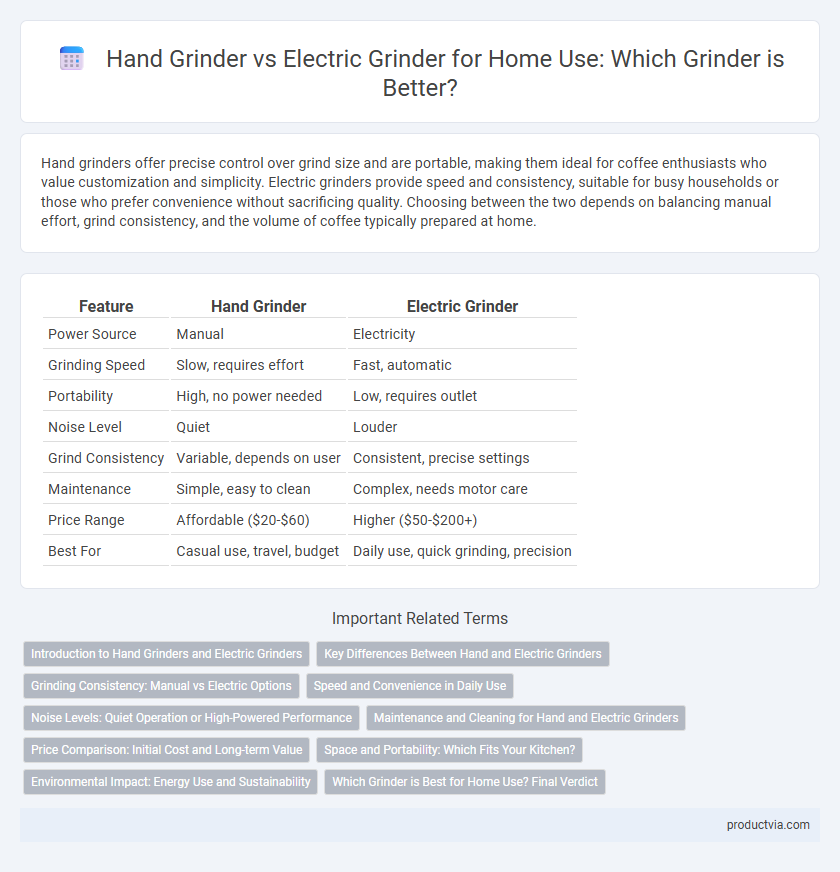Hand grinders offer precise control over grind size and are portable, making them ideal for coffee enthusiasts who value customization and simplicity. Electric grinders provide speed and consistency, suitable for busy households or those who prefer convenience without sacrificing quality. Choosing between the two depends on balancing manual effort, grind consistency, and the volume of coffee typically prepared at home.
Table of Comparison
| Feature | Hand Grinder | Electric Grinder |
|---|---|---|
| Power Source | Manual | Electricity |
| Grinding Speed | Slow, requires effort | Fast, automatic |
| Portability | High, no power needed | Low, requires outlet |
| Noise Level | Quiet | Louder |
| Grind Consistency | Variable, depends on user | Consistent, precise settings |
| Maintenance | Simple, easy to clean | Complex, needs motor care |
| Price Range | Affordable ($20-$60) | Higher ($50-$200+) |
| Best For | Casual use, travel, budget | Daily use, quick grinding, precision |
Introduction to Hand Grinders and Electric Grinders
Hand grinders feature a manual crank mechanism, allowing precise control over grind size and consistency, ideal for small coffee batches in home settings. Electric grinders operate with automated motors, providing faster and more convenient grinding with adjustable settings for various brew methods. Choosing between the two depends on factors like grind precision, speed, noise level, and user preference for traditional manual operation versus electric efficiency.
Key Differences Between Hand and Electric Grinders
Hand grinders offer precise control over grind size, allowing users to adjust settings manually for tailored coffee or spice textures. Electric grinders provide speed and convenience, efficiently processing larger quantities with consistent results through automated grinding mechanisms. Noise level, portability, and maintenance requirements also differ, with hand grinders being quieter and more portable, while electric grinders demand regular cleaning and are bulkier for home use.
Grinding Consistency: Manual vs Electric Options
Hand grinders provide precise control over grind size, producing consistent results through adjustable burr settings that suit various brewing methods, but require more effort and time. Electric grinders offer fast, uniform grinding with advanced motor technology and programmable settings, ensuring repeatable consistency ideal for busy home environments. While manual grinders excel in portability and quiet operation, electric grinders dominate in efficiency and convenience for daily coffee preparation.
Speed and Convenience in Daily Use
Hand grinders offer precise control and quieter operation but require more time and effort, making them ideal for those who prioritize flavor and freshness. Electric grinders excel in speed and convenience, quickly grinding coffee with minimal effort, perfect for busy households or multiple cups. Choosing between them depends on the balance between time efficiency and the ritual of manual grinding.
Noise Levels: Quiet Operation or High-Powered Performance
Hand grinders produce minimal noise, making them ideal for quiet, early-morning coffee preparation without disturbing others. Electric grinders tend to generate higher noise levels due to their powerful motors, offering faster grinding but less subtle operation. Choosing between the two depends on prioritizing silent, hands-on control or quick, high-powered performance.
Maintenance and Cleaning for Hand and Electric Grinders
Hand grinders require minimal maintenance, involving regular disassembly and thorough cleaning of burrs and hoppers to prevent coffee residue buildup and ensure optimal grinding consistency. Electric grinders often have more components, including motors and sensors, necessitating careful cleaning with brushes and occasional deep maintenance to avoid motor damage and ensure longevity. Properly maintained hand grinders typically offer easier cleaning routines, making them a preferred choice for users prioritizing simple upkeep and durability at home.
Price Comparison: Initial Cost and Long-term Value
Hand grinders typically have a lower initial cost, ranging from $20 to $60, making them an affordable choice for budget-conscious users. Electric grinders, priced between $50 and $300, involve a higher upfront investment but offer consistent grind quality and save time for frequent use. Over the long term, hand grinders require minimal maintenance and no electricity, creating value in energy savings, while electric grinders provide convenience that may justify their higher cost for heavy coffee drinkers.
Space and Portability: Which Fits Your Kitchen?
Hand grinders offer compact designs that save counter space and are highly portable, making them ideal for small kitchens or frequent travelers. Electric grinders typically require more space due to their larger size and power cords, limiting portability and kitchen placement options. Choosing between the two depends on your kitchen's size constraints and whether you prioritize convenience or mobility.
Environmental Impact: Energy Use and Sustainability
Hand grinders consume no electricity, significantly reducing energy use and carbon emissions compared to electric grinders, making them a more sustainable option for home use. The manual operation relies on human power, which eliminates the dependency on fossil fuels and decreases the household's overall environmental footprint. Materials used in hand grinders are often more durable and simpler to recycle, whereas electric grinders involve electronic components that contribute to e-waste and resource depletion.
Which Grinder is Best for Home Use? Final Verdict
Hand grinders offer precise control and consistency, making them ideal for coffee enthusiasts who value a customizable grind and minimal heat buildup. Electric grinders provide convenience and speed, suitable for busy households needing quick, uniform grinds with less effort. For home use, the best grinder depends on whether you prioritize precision and manual crafting or speed and ease of use.
Hand Grinder vs Electric Grinder for Home Use Infographic

 productvia.com
productvia.com